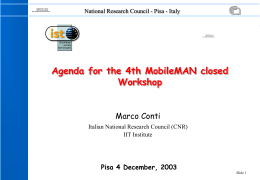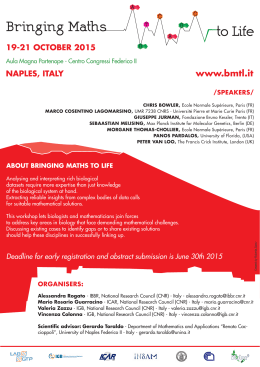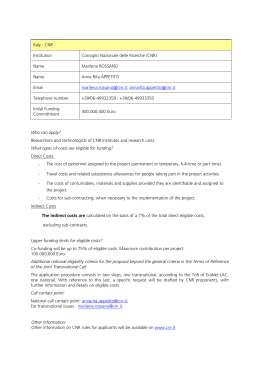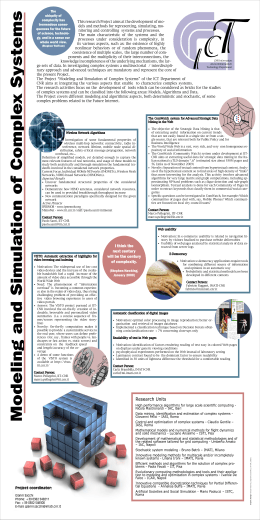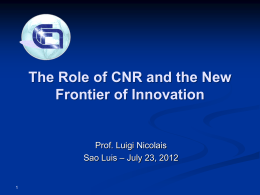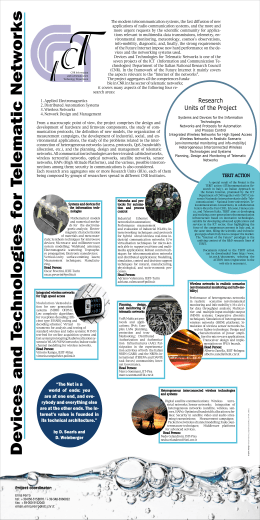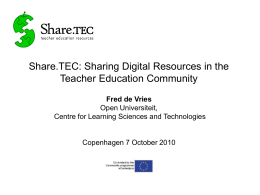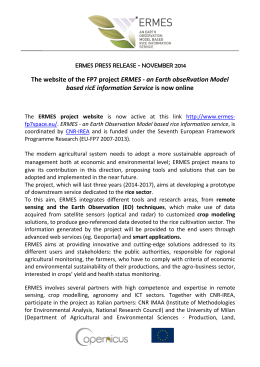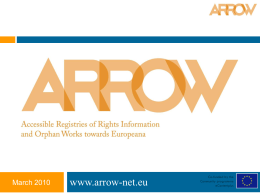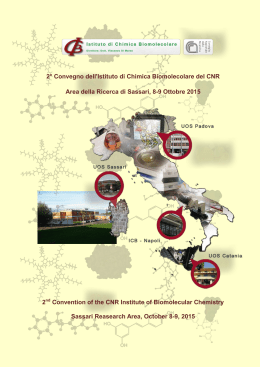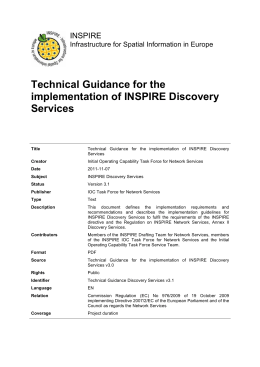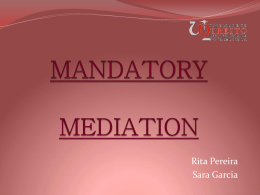From CNR annual report to an Institutional Repository: which successful strategies? Rosa Di Cesare, Roberta Ruggieri, Loredana Cerbara, Daniela Luzi Consiglio Nazionale delle Ricerche, Istituto di Ricerche sulla Popolazione e le Politiche Sociali mailto d.cesare, d.luzi, r.ruggieri,l.cerbara@irpps.cnr.it Background of the study In 2008 a CNR OA supporter group promoted a survey to acquire a precise picture of OA CNR practices Main result of the survey was: • Identification of the current electronic acquisition system of CNR scientific production as a building block for a future IR CNR OA supporter group required CNR top management to sign the Berlin Declaration and start the development of a CNR’s IR Currently the Top management is developing an OAI-PMH compliant IR on the basis of the previous electronic acquisition system Aim Analysis of the information content of the actual database (document types, quality of bibliographic descriptions) To provide a contribution in: • Identification of metadata able to describe GL documents • Development of guidelines focusing on the identification of GL bibliographic collections Survey design Preliminary information Analysis of document types produced by CNR Departments First Level SAMPLE DESIGN Survey 2008 Interview with the person in charge for the management and implementation of the current CNR central database Literature review within the universe composed by 107 CNR research units, we selected a random sample of 21 units (units=Institutes) Second Level FINAL SAMPLE DESIGN within GL documents produced by the selected units, we selected a random sample of documents proportional to the Institutes’ GL scientific production (units=GL document) Qualitative analysis Profile of the universe Percentage of GL documents by Department (2003-2007) Life sciences Materials & devices Molecular design Medicine Cultural identity Agriculture & food Hearth & environment Cultural heritage Energy & transportation ICT Advanced manufacturing systems 0 10 20 30 40 source: http://www.cnr.it/istituti/Retescientifica.html/ 50 60 70 Bibliographic collections by Departments (2003-2007) Depa rtment Tota l number of publi ca tions Journa l a rti cl es Book s a nd book cha pters Conf pa pers Ora l presenta ti ons Reports In-house publi ca tions Other Hearth & nvironment 16757 32,2 8,5 16,6 27,9 10,7 1,4 2,7 Energy and transportation 3529 35,6 2,0 27,7 18,1 13,6 0,3 2,7 Agriculture & f ood 6963 36,0 6,6 17,2 28,2 6,8 0,9 4,3 Medicine 8207 50,0 3,2 6,1 36,4 2,2 0,3 1,7 Lif e sciences 1980 67,7 2,8 1,4 25,9 0,9 1,2 0,2 Molecular design 10514 56,9 2,8 9,2 24,8 3,1 0,3 2,7 Materials & devices Advanced manif acturing systems 15292 64,9 2,9 12,3 13,9 3,0 1,0 2,1 5019 29,2 3,3 19,8 15,0 19,5 1,2 11,9 ICT 7023 30,9 5,4 29,4 9,8 17,5 3,2 3,8 Cultural identity 9262 22,6 24,0 13,5 20,4 10,9 5,3 3,3 Cultural heritage 2154 21,8 18,4 30,8 15,0 7,8 1,5 4,6 Tota l 86700 42,4 7,1 15,6 21,7 8,4 1,6 3,3 source: http://www.cnr.it/istituti/Retescientifica.html/ Sample: Institutes and documents Department Research units Sampled Total numb er Total of research of documents numb er of GL GL Sampled GL examined units produced documents documents (pre-text) Hearth & environment 13 3 3295 1985 114 53 Materials & devices 12 3 6550 1064 60 34 Molecular design 14 3 2072 1059 59 43 Cultural identity 15 3 1945 952 51 57 Medicine 12 2 1784 983 54 24 ICT 7 1 1010 558 31 19 Agriculture & f ood 10 2 2375 1342 73 38 Advanced manufacturing systems 7 1 631 415 24 14 Energy and transportation 6 1 431 262 14 8 Cultural heritage 5 1 464 281 15 15 Lif e sciences 6 1 74 36 2 6 107 21 20631 8937 497 311 Total GL documents examined: Data was collected directly from primary source; Data analysed: publications produced in the period 2003-2007; Data was gathered in September 2009 We selected following GL document types: • conference papers • oral presentations • reports • In-house publications Qualitative analysis considers: - metadata used to describe each GL document type - use of note field and analysis of its content • Verify whether the actual metadata are suitable to describe GL document types • Verify whether the note field is used to increase the information consistency of the bibliographic record Conference papers Metadata Note field Content Mandatory fields: Conference types: International or national, ISI indexed Invited / Invited & ISI Refereed Author & institution information: author affiliation, author’s research project, author ID Optional fields: Conference title and location Subject categories Missing fields: Conference date Conference bibliographic description (title, editors, publisher, ect.) 26% of analyzed documents have the note field compiled access point 4% additional information 4% conference date 9% conference bibliographic description 83% Oral presentations Metadata Mandatory fields: Item types: international or national abstract/poster, communication/relation, invited Author & institution information: author affiliation, author research project, author ID Note field Content 20% of analyzed documents have the note field compiled access point 6% conference date 6% additional information 49% Optional fields : Conference title and location Subject categories Missing fields: Conference date Conference bibliographic description (title, editors, publisher, ect.) error 11% conference bibliographic description 28% Reports Metadata Mandatory fields: Item types: technical reports, project reports, guideline/manual, multimedia products, databases, Author & institution information: author affiliation, author research project, author ID Format: cd-rom, floppy disk ect. Optional fields Note field Content 52% of analyzed documents have the note field compiled report bibliographic description 49% additional information 10% Subject categories Missing fields: Report series and Report number Project description (project title , project number, contract number) project description 41% In-house publications Collection of documents published by CNR Units: high variety of document types Metadata Mandatory fields: Document types: monograph & serials catalogue & databases excerpt supplement … Author & institution information: author affiliation, author research project, author ID Note field Content 47% analyzed documents have the note field compiled bibliographic description 48% bibliographic indentifier 33% Optional fields Bibliographic references Subject categories Missing fields: No specific bibliographic description fields related to document types additional information 19% First remarks Background of current document acquisition system Designed within a set of databases oriented to collect managerial data containing also research outputs (i.e. CNR Annual report) Mandatory and daily used by all CNR Research units: it now contains the research outputs starting from 2002 (= more than 90.000) Characteristics of the current document acquisition system: Presence of a core set of metadata of the identified document types Integration with other internal databases (i.e. authors IDs, CNR Projects, …) Provision of disciplinary categories & keywords Special emphasis on data related to evaluation (ISI, invited presentations, …) Missing metadata for a correct GL document type description Conclusions and future works • High percentage of the use of the Note field to describe GL documents • Higher percentage for: – Greyer documents – GL documents described within no well defined collections • The highest percentage refers to Reports where Notes supplement lacking metadata Does homogenous description reported in the Notes depend on librarians inserting data? Survey results are a contribution to the identification and organisation of collections - in particular GL - and are the basis of the development of guidelines that enhance data quality as well as help information providers to submit research outputs
Scarica
